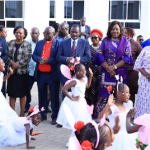Carnegie Hall recently experienced a historic first with the Africa United Youth Orchestra’s (Auyo) debut performance, offering a poignant tribute to African musical heritage through classical excellence.
The anticipation was palpable as Auyo, a diverse ensemble of young musicians from various corners of Africa, took the stage at the iconic venue. The audience, representing a rich tapestry of cultures, settled into their seats as the lights dimmed, signaling the start of a momentous event.
The stage was a vibrant display of talent, with instruments gleaming under the spotlight. The orchestra, featuring strings, woodwinds, brass, and percussion, showcased the evening’s grand scale.
The concert opened with a tribute to South African musical heritage, featuring Michael Moerane’s *Fatse Laheso*, the first symphonic work by a black South African, composed in 1941. The piece, meaning “My Country,” resonated deeply with its narrative of pride and resilience, earning a standing ovation from the audience.
Following this, the orchestra performed Mziliga Zikumalo’s *uShaka KaSenzangakhona* and *Princess Magogo kaDinuzulu*, the first Zulu opera. The music flowed beautifully, highlighting the rich tradition of African operatic art. Despite their youth, the musicians played with impressive maturity and passion, immersing the audience in a world of myth and majesty.
The evening’s highlight was Bongani Ndodana-Breen’s three-song cycle, inspired by the Yonka poems famously read by Nelson Mandela in Parliament. The performance of Afrikaans for the first time at Carnegie Hall left the audience spellbound, marking a significant historical moment for both the performers and the venue.
Mark Weiz of the Nairobi Music Society remarked that the performance was a powerful cultural statement, reflecting a shift in global cultural dynamics where African voices are increasingly central to the narrative.
“The ability of these young musicians to perform such complex works at a venue like Carnegie Hall signals a new era of recognition and respect for African contributions to classical music,” he said.
“It opens up new possibilities for African musicians in the global arena.
At just 20 years, Gilah Kellner of Stellenbosch University’s Music Department is Auyo’s Concertmaster, the highest leadership position after the conductor.
“I think every violinist who has dreams of becoming a real, professional musician, dreams of playing in Carnegie Hall,” she told reporters.
“But I didn’t quite realise the weight of this until I stepped into the hall and the conductor was telling us, like, this is where legends have stood. People you know are absolute stars.
“This is also the first time a whole African orchestra has played on this stage. It was such an… it’s the greatest one.”
Blandina Dimanda, 22, from Maputo, Mozambique, only started playing the violin in 2016 but described this trip as a huge moment to represent her country on the global stage.
For Olawale Olayinka, 30, a Nigerian violinist from Nigeria’s Osun state who has played the instrument since 2010, performing at Carnegie Hall was exhilarating.
“When I got the message about the auditions to get into the Auyo, I said, yes, I have to be a part of this. I just would not let this opportunity go because it’s golden,” he said.
The performance concluded with a thunderous ovation, a standing tribute to the young musicians who had seamlessly bridged continents and cultures with their exceptional talent. The conductor, radiating pride, acknowledged the enthusiastic response with a gracious bow, his baton raised in triumph.
Following their Carnegie Hall success, the African musicians joined an international assembly of youth orchestras from China, the European Union, Afghanistan, Venezuela, and the United States.
This impressive ensemble of over 700 musicians was conducted by the renowned Gustavo Dudamel, music director of the Los Angeles Philharmonic and future music and artistic director of the New York Philharmonic.
Under Dudamel’s guidance, the orchestra embarked on a symphonic journey that transcended borders and languages.
The grand finale of World Orchestra Week celebrated the unifying power of music, showcasing how a shared passion can bring together people from diverse backgrounds in harmony and understanding.
One of the standout pieces, “Pata Pata,” popularized internationally by the iconic Miriam Makeba, was performed with vibrant energy that honored its origins while integrating it into a grand orchestral setting.
This piece, among others, exemplified the concert’s goal: to present music that reflects South Africa’s rich cultural heritage and to include works by composers from other parts of Africa in future performances.



